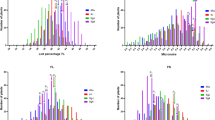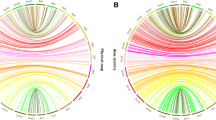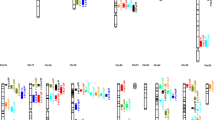Abstract
Genetic mapping is an essential tool for cotton (Gossypium hirsutum L.) molecular breeding and application of DNA markers for cotton improvement. In this present study, we evaluated an RI population including 188 RI lines developed from 94 F2-derived families and their two parental lines, ‘HS 46’ and ‘MARCABUCAG8US-1-88’, at Mississippi State, MS, for two years. Fourteen agronomic and fiber traits were measured. One hundred forty one (141) polymorphic SSR markers were screened for this population and 125 markers were used to construct a linkage map. Twenty six linkage groups were constructed, covering 125 SSR loci and 965 cM of overall map distance. Twenty four linkage groups (115 SSR loci) were assigned to specific chromosomes. Quantitative genetic analysis showed that the genotypic effects accounted for more than 20% of the phenotypic variation for all traits except fiber perimeter (18%). Fifty six QTLs (LOD > 3.0) associated with 14 agronomic and fiber traits were located on 17 chromosomes. One QTL associated with fiber elongation was located on linkage group LGU01. Nine chromosomes in sub-A genome harbored 27 QTLs with 10 associated with agronomic traits and 17 with fiber traits. Eight chromosomes in D sub-genome harbored 29 QTLs with 13 associated with agronomic traits and 16 with fiber traits. Chromosomes 3, 5, 12, 13, 14, 16, 20, and 26 harbor important QTLs for both yield and fiber quality compared to other chromosomes. Since this RI population was developed from an intraspecific cross within upland cotton, these QTLs should be useful for marker assisted selection for improving breeding efficiency in cotton line development.


Similar content being viewed by others
References
Burr B, Burr FA (1991) Recombinant inbred for molecular mapping in maize: theoretical and practical considerations. Trends Genet 7:55–60
Burr B, Burr FA, Thompson KH, Albertson MC, Stuber C (1988) Gene mapping with recombinant inbreds in maize. Genetics 118:519–526
Brubaker CL, Wendel JF (2001) RFLP diversity in cotton. In: Saha S, Jenkins JN (eds) Genetic improvement of cotton emerging technologies. Science Pulisher Inc, Enfield, CO, pp 3–31
Fehr W (1987) Principles of cultivar development: volume one, theory and technique. Macmillan Publishing Co., New York
Frelichowski JM, Palmer MB, Main D, Tomkins JP, Cantrell RG, Stelly DM et al (2006) Cotton genome mapping with new microsatellites from Acala ‘Maxxa’ BAC-ends. Mol Genet Genomics 275:479–491. doi:10.1007/s00438-006-0106-z
Gutierrez OA, Basu S, Saha S, Jenkins JN, Shoemaker DB, Cheatham CL et al (2002) Genetic distance among selected cotton genotypes and its relationship with F2 performance. Crop Sci 42:1841–1847
Han Z, Guo W, Song X, Zhang T (2004) Genetic mapping of EST-derived microsatellites from the diploid Gossypium arboreum in allotetraploid cotton. Mol Genet Genomics 272(3):308–327. doi:10.1007/s00438-004-1059-8
Han Z, Wang C, Song X, Guo W, Gou J, Li C et al (2006) Characteristics, development and mapping of Gossypium hirsutum derived EST-SSRs in allotetraploid cotton. Theor Appl Genet 112:430–439. doi:10.1007/s00122-005-0142-9
Horne EC, Kumpatla SP, Patterson KA, Gupta M, Thompson SA (2004) Improved protocols for high-throughput sunflower and cotton genomic DNA extraction and PCR fidelity. Plant Mol Biol Rep 22:83–84. doi:10.1007/BF02773352
Jenkins JN, Wu J, McCarty JC, Saha S, Gutiérrez OA, Hayes R et al (2006) Genetic effects of thirteen Gossypium barbadense L. chromosome substitution lines in topcrosses with upland cotton cultivars: I. yield and yield components. Crop Sci 46:1169–1178. doi:10.2135/cropsci2005.08-0269
Jenkins JN, McCarty JC, Wu J, Saha S, Gutiérrez OA, Hayes R et al (2007) Genetic effects of thirteen Gossypium barbadense L. chromosome substitution lines in topcrosses with upland cotton cultivars: II. fiber quality traits. Crop Sci 47:561–572
Jiang C, Wright RJ, El-Zik KM, Paterson AH (1998) Polyploid formation created unique avenues for response to selection in Gossypium (cotton). Proc Natl Acad Sci USA 95:4419–4424. doi:10.1073/pnas.95.8.4419
Kohel RJ, Yu J, Park YH, Lazo GR (2001) Molecular mapping and characterization of traits controlling fiber quality in cotton. Euphytica 121:163–172. doi:10.1023/A:1012263413418
Kosambi DD (1944) The estimation of map distances from recombination values. Ann Eugen 12:172–175
Lacape JM, Nguyen TB, Thibivilliers S, Bojinov B, Courtois B, Cantrell RG et al (2003) A combined RFLP-SSR-AFLP map of tetraploid cotton based on a Gossypium hirsutum × Gossypium barbadense backcross population. Genome 46:612–626. doi:10.1139/g03-050
Lacape JM, Nguyen TB, Courtois B, Belot JL, Giband M, Gourlot JP et al (2005) QTL analysis of cotton fiber quality using multiple Gossypium hirsutum × Gossypium barbadense backcross generations. Crop Sci 45:123–140
Lin Z, He D, Zhang X, Nie Y, Guo X, Feng C et al (2005) Linkage map construction and mapping QTL for cotton fibre quality using SRAP, SSR and RAPD. Plant Breed 124:180–187. doi:10.1111/j.1439-0523.2004.01039.x
Liu S, Cantrell G, McCarty JC, Stewart JM (2000a) Simple sequence repeat-based assessment of genetic diversity in cotton race stock accessions. Crop Sci 40:1459–1469
Liu S, Saha S, Stelly D, Burr B, Cantrell RG (2000b) Chromosomal assignment of microsatellite loci in cotton. J Hered 91:326–332. doi:10.1093/jhered/91.4.326
Miller RG (1974) The jackknife: a review. Biometrika 61:1–15
Nguyen TB, Giband M, Brottier P, Risterucci AM, Lacape JM (2004) Wide coverage of the tetraploid cotton genome using newly developed microsatellite markers. Theor Appl Genet 109:167–175. doi:10.1007/s00122-004-1612-1
Park YH, Alabady MS, Ulloa M, Sickler B, Wilkins TA, Yu J et al (2005) Genetic mapping of new cotton fiber loci using EST-derived microsatellites in an interspecific recombinant inbred line cotton population. Mol Genet Genomics 274:428–441. doi:10.1007/s00438-005-0037-0
Qureshi SN, Saha S, Kantety RV, Jenkins JN (2004) EST-SSR: a new class of genetic markers in cotton. J Cotton Sci 8:112–123
Rao CR (1971) Estimation of variance and covariance components MINQUE theory. J Multivariate Anal 1:257–275. doi:10.1016/0047-259X(71)90001-7
Reinisch AJ, Dong J, Brubaker CL, Stelly DM, Wendel JF, Paterson AH (1994) A detailed RFLP map of cotton, Gossypium hirsutum × Gossypium barbadense: chromosome organization and evolution in a disomic polyploidy genome. Genetics 138:829–847
Rong J, Abbey C, Bowers JE, Brubaker CL, Chang C, Chee PW et al (2004) A 3347-locus genetic recombination map of sequence-tagged sites reveals features of genome organization, transmission and evolution of cotton (Gossypium). Genetics 166:389–417. doi:10.1534/genetics.166.1.389
Saha S, Callahan FE, Dollar DA, Creech JB (1997) Effect of lyophilization of cotton tissue on quality of extractable DNA, RNA, and protein. J Cotton Sci 1:10–14
Saha S, Wu J, Jenkins JN, McCarty JC, Gutiérrez O, Stelly DM et al (2004) Effects of chromosome substitution from Gossypium barbadense L. into G. hirsutum L. TM-1 on agronomic and fiber traits. J Cotton Sci 8:162–169
Saha S, Jenkins JN, Wu J, McCarty JC, Gutiérrez O, Percy RG et al (2006) Effects of chromosome-specific introgression in upland cotton on fiber and agronomic traits. Genetics 172:1927–1938. doi:10.1534/genetics.105.053371
SAS Institute Inc (1999) SAS software Version 8.0. SAS Institute, Cary, NC
Shappley ZW, Jenkins JN, Meredith WR, McCarty JC (1998a) An RFLP linkage map of upland cotton (Gossypium hirsutum L.). Theor Appl Genet 97:756–761. doi:10.1007/s001220050952
Shappley ZW, Jenkins JN, Zhu McCarty JC (1998b) Quantitative traits loci associated with agronomic and fiber traits of upland cotton. J Cotton Sci 4:153–163
Shen X, Guo W, Zhu X, Yuan Y, Yu J, Kohel R et al (2005) Molecular mapping of QTLs for fiber qualities in three diverse lines in Upland cotton using SSR markers. Mol Breed 15:169–181. doi:10.1007/s11032-004-4731-0
Shen X, Zhang T, Guo W, Zhu X, Zhang X (2006) Mapping fiber and yield QTLs with main, epistatic, and QTL × Environment interaction effects in recombinant inbred lines of upland cotton. Crop Sci:61–66.
Tanksley SD, McCough SR (1997) Seed banks and molecular maps: unlocking genetic potential from the wild. Science 277:1063–1066. doi:10.1126/science.277.5329.1063
Tomkins JP, Peterson DG, Yang TJ, Main D, Wilkins TA, Paterson AH et al (2001) Development of genomic resources for cotton (Gossypium hirsutum L.): BAC library construction, preliminary STC analysis, and identification of clones associated with fiber development. Mol Breed 8(3):255–261. doi:10.1023/A:1013798716098
Ulloa M, Meredith WR (2000) Genetic linkage map and QTL analysis of agronomic and fiber traits in an intraspecific population. J Cotton Sci 4:161–170
Ulloa M, Meredith WR, Shappley ZW, Kahler AL (2002) RFLP genetic linkage maps from four F2.3 populations and a joinmap of Gossypium hirsutum L. Theor Appl Genet 104:200–208. doi:10.1007/s001220100739
Ulloa M, Saha S, Jenkins JN, Meredith WR, McCarty JC, Stelly DM (2005) Chromosomal assignment of RFLP linkage groups harboring important QTLs on an intraspecific cotton (Gossypium hirsutum L.) joinmap. J Hered 96:132–144. doi:10.1093/jhered/esi020
Van Ooijen JW, Voorrips RE (2001) JoinMap® 3.0, Software for the calculation of genetic linkage maps. Plant Research International, Wageningen, The Netherlands
Wang D, Zhu J, Li Z, Paterson AH (1999) Mapping QTLs with epistatic effects and QTL × environment interactions by mixed linear model approaches. Theor Appl Genet 99:1255–1264. doi:10.1007/s001220051331
Wu J (2001) Comparisons on properties of marker linkage and QTL mapping between two methods of recombinant line development. Ph.D. dissertation, Zhejiang University, Hangzhou, China
Wu J (2003) Genetic variation, conditional analysis, and QTL mapping for agronomic and fiber traits in upland cotton. Ph.D. diss. Diss. Abstra. Int. 64-09B:4119), Mississippi State Univ., Mississippi State, MS
Wu J, Jenkins JN, Zhu J, McCarty JC, Watson CE (2003a) Comparisons of QTL mapping properties for two methods of recombinant inbred line development. Euphytica 132:159–166. doi:10.1023/A:1024690711867
Wu J, Zhu J, Jenkins JN (2003b) Mixed linear model approaches in quantitative genetic models (book chapter) In: Formulars, software, and techniques for genetics and breeders. The Haworth Reference Press Inc., New York
Wu J, Jenkins JN, Zhu J, McCarty JC, Watson CE (2003c) Monte Carlo simulations on marker grouping and ordering. Theor Appl Genet 107:568–573. doi:10.1007/s00122-003-1283-3
Wu J, Jenkins JN, McCarty JC, Zhu J (2004) Genetic association of yield with its component traits for upland cotton recombinant inbred lines. Euphytica 140:171–179. doi:10.1007/s10681-004-2897-5
Zhang T, Yuan Y, Yu J, Guo W, Kohel RJ (2003) Molecular tagging of a major QTL for fiber strength in Upland cotton and its marker-assisted selection. Theor Appl Genet 106:262–268
Zhang Z, Xiao Y, Luo M, Li X, Luo X, Hou L et al (2005) Construction of a genetic linkage map and QTL analysis of fiber-related traits in upland cotton (Gossypium hirsutum L.). Euphytica 144(1):91–99. doi:10.1007/s10681-005-4629-x
Zhu J (1989) Estimation of genetic variance components in the general mixed model. Ph.D. Dissertation, North Carolina State University, Raleigh, NC
Zhu J (1993) Methods of predicting genotype value and heterosis for offspring of hybrids. J Biomathematics Chin 8(1):32–44
Author information
Authors and Affiliations
Corresponding authors
Additional information
Paper number J1116 of the Mississippi Agricultural and Forestry Experiment Station, Mississippi State University, Mississippi State, MS 39762. Mention of trademark, proprietary product, or vendor does not constitute a guarantee or warranty of the product by USDA, ARS and does not imply its approval to the exclusion of other products or vendors that may also be suitable.
Rights and permissions
About this article
Cite this article
Wu, J., Gutierrez, O.A., Jenkins, J.N. et al. Quantitative analysis and QTL mapping for agronomic and fiber traits in an RI population of upland cotton. Euphytica 165, 231–245 (2009). https://doi.org/10.1007/s10681-008-9748-8
Received:
Accepted:
Published:
Issue Date:
DOI: https://doi.org/10.1007/s10681-008-9748-8




